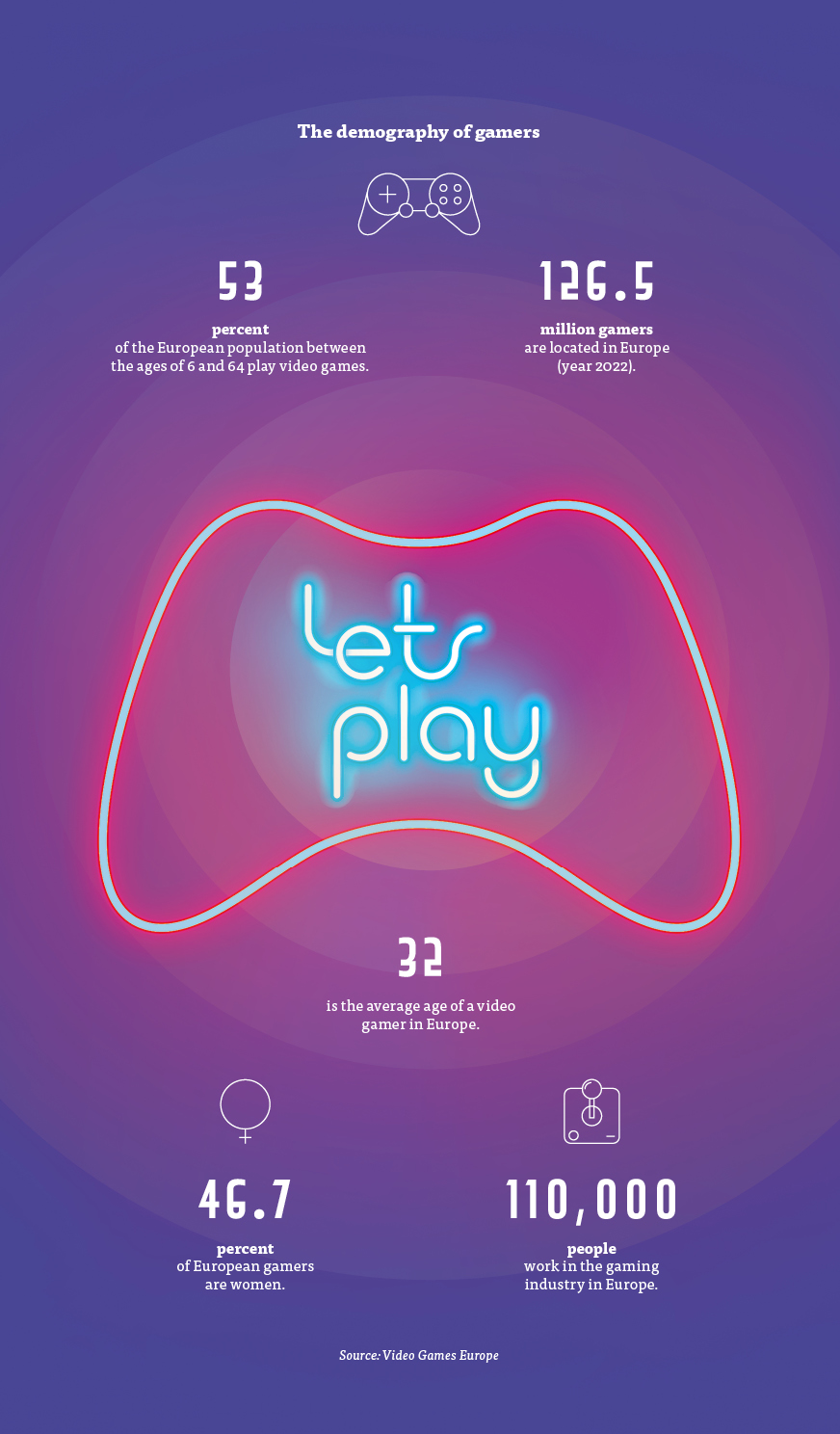Immersion is the key term in the gaming sector. Gamers want to dive into the game, to experience the virtual world as realistically as possible. The industry is continually bringing new solutions onto the market – from game controllers to Brain Computer Interfaces.
Anyone who has ever been engrossed in a game knows what “immersive” means. It comes from the Latin “immersio,” meaning to dive in. In the context of computer games, the word describes the extent to which a player perceives themselves to become part of the game world. Besides the pure visuals, such as a first-person perspective, the interaction with the virtual world is decisive.

Familiarity with Digital Technology
The industry uses all the possibilities offered by modern Human Machine Interfaces, making it an exciting testing ground for new technologies. “Gaming is more than just entertainment. Through interactive gaming experiences, users are playfully familiarised with modern technology. As they dive into virtual worlds, they intuitively learn to handle digital interfaces, menus and control options,” says Dr Sebastian Klöß, head of Consumer Technology at Bitkom. Young people’s familiarity with complex Human Machine Interfaces is even utilised by the military, which uses HMIs resembling gaming controllers rather than military equipment – many systems can be used by young soldiers without intensive training.
Haptic feedback in controllers
To achieve the goal of an immersive gaming experience, manufacturers are constantly coming up with new ideas. This starts with the “simple” controller such as the PlayStation 5 from Sony: it makes the game action palpable through haptically fine-tunable vibrations. Adaptive triggers allow the adjustment of the analog shoulder buttons. In this way, certain activities in the game, such as shooting, accelerating and jumping, become more nuanced. Moreover, Sony has recently patented a new controller design that integrates an elastic area that can change its shape and temperature and respond to various physical inputs such as pressing or rubbing. This would offer new possibilities for immersion, such as the controller being able to enhance intense game moments with heat.
Measured pressure
Keyboards with force sensor technology are already a reality, although they may not be as visionary as some other technologies. They are used, for example, in special gaming laptops. Typically, the W, A, S and D keys are supplemented by a force function, making the keyboard much more intuitive and sensory for players to operate. “Imagine driving down your local highway and your accelerator is restricted to just 2 options, ‘off’ or ‘full speed’. Reality-based physics calls for acceleration dependent on how hard you press on the accelerator pedal, or how hard you turn the steering wheel. This is the difference Peratech intelligent tactile sensing makes,” explains Jim Thomas, CCO of Peratech. The company equips, for example, the Lenovo Legion 7i and 7 gaming laptops with corresponding force keys.
Capturing head movements
Lenovo’s top model can also capture the player’s head movements. The integrated software solution from Tobii Horizon uses the laptop’s built-in camera for this purpose. Players can thus control the field of view in the game with their head movements. When a player turns their head to the right, the camera follows his gaze to the right. This is particularly helpful in games where it is important to be aware of the surroundings, such as in first-person shooters or racing games.
Diving into Virtual Reality
Players can truly dive into a game through virtual reality and augmented reality technologies. Special VR glasses let the player sink into the artificially created, virtual world. These headsets can be mounts into which a smartphone is inserted, such as with Samsung Gear, or so-called “Head Mounted Displays”, which integrate the entire technology, such as Microsoft’s Hololens. In both approaches, the player is at the centre, and their virtual view follows their own movement. With its immersive and interactive nature, virtual reality has revolutionised the way games are experienced. But VR becomes truly “immersive” with input devices specially designed to make the virtual world seem more real.
Interacting with objects
Like the Oculus Touch: these handheld devices are designed to mimic hand movements in the virtual world. Equipped with sensors, buttons and triggers, the system allows the player to interact with objects and move precisely and effortlessly through virtual environments. The VR controller HTC Vive Wand also features haptic feedback – allowing the player to feel the virtual objects they interact with.
Playing with body movements
The gaming experience becomes completely realistic when the movements of the entire body can be used to guide the character through the virtual world: jumping, running, kneeling – all captured by full-body tracking systems like Omni One from Virtuix. It is an omnidirectional treadmill that allows players to walk or run in any direction through video games and other virtual environments. It is currently shipped with a Pico Neo 3 Pro headset with 6DoF technology (6 Degrees of Freedom) and additional hand controllers for hand and gesture tracking.
Empathise with the avatar
For players who still want more, in future they will be able to experience their characters’ suffering from the game. For instance, the game provider Ubisoft plans to offer a shirt with haptic feedback for its game Assassin’s Creed Mirage. With the Haptic Gaming System from OWO, the player is supposed to experience sensations on the body that correspond with the actions in the game. “By leveraging OWO’s groundbreaking technologies and expertise, we are able to immerse players in the world, sounds and sensations of Assassin’s Creed Mirage in an innovative and enhanced way,” Fabian Salomon, lead producer at Ubisoft Bordeaux. The sensations that the shirt can convey range from wind or free fall to knife stabs, thus also exploring the limits of immersion.
Seamless interaction
But the future of VR controllers goes even beyond that. Companies like Neurable are working on Brain Computer Interfaces that allow players to control virtual environments with their thoughts. The company, a spin-off from the University of Michigan, is developing neurotechnological reference designs, APIs and capabilities that function outside of laboratory conditions and can be integrated into everyday technologies. Neurable licenses its technology for headphones, earbuds and AR devices. Dr Ramses Alcaide, CEO of Neurable, is sure that: “This is just the beginning for neurotechnology. We are at the cusp of being able to ethically create a seamless relationship between people and their technology.”

